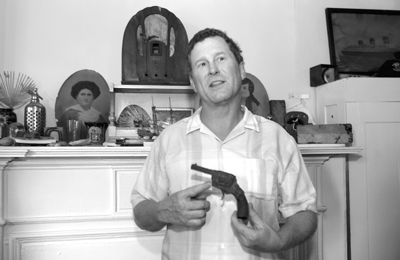By Albert Amateau
Keeping a 186-year-old wooden beach house standing and functioning as living quarters, office and pub is no easy task. Especially one condemned as unfit for use back in 1906.
But Rip Hayman, owner of the James Brown House at 326 Spring St. gets along, with a little help from friends.
The house, built before 1817, is a designated landmark and the Ear Inn, a pub on the ground floor, is a favorite neighborhood destination. Recently, the Greenwich Village Society for Historic Preservation joined with Hayman and Andy Coe — author of “Ear Inn Virons,” a book (as its punning title indicates) about the history of the property and neighborhood — in a guided tour of the building.
The three-story house, originally the home of an African-American Revolutionary War veteran who ran a tobacco shop on the ground floor, has uneven floors, stairs that slant at an odd angle and a unique ambiance.
“This is sand from the foundation of the building,” said Hayman, holding a beer stein full of grayish sand. The house, now a block and a half from the Hudson River, was right on the riverbank in the early decades of the 19th century. “There was a sand spit in the river at Canal St. at that time,” said Hayman. “We have to pump out the tide from the basement twice a day.”
Hayman first rented a room in the house in 1973 when he was a Columbia University student. He paid $100 a month rent to Harry Jacobs who ran the unnamed pub known to neighbors as “The Green Door.” In 1977, Hayman and friends bought the house and the pub.
“We were publishing ‘The Ear,’ a new music journal, at the time and we decided to name the pub after it,” said Hayman. The city landmarks commission didn’t allow new signage, so a coat of black paint covering the curved neon tubes of the “B” in the pub’s BAR sign was sufficient for EAR.
Although James Brown sold tobacco on the first floor, the shop has been a pub for at least 150 years, said Hayman, who has a collection of whiskey jugs found in the basement of the place. The records show there was a bar in the building in 1835 and it was likely there for some years before.
Hayman keeps a revolver, which he found several years ago tucked in the flue of the second floor fireplace. “It’s a five-shot revolver made around 1900,” he said. “I can imagine the circumstances when it was hidden.”
Hayman, who is a principal in Odyssey Publications, a publishing firm with offices in the James Brown House, is no longer active in the Ear Inn, where he used to tend bar. Nevertheless, Martin Sheridan, who runs the Ear, helps maintain the old house. It takes a lot of maintenance.
“We have crack gauges all over the walls,” Hayman said. “Whenever we have engineers inspect the place they go, ‘Oh boy,’ and shake their heads.”
Hayman says he is worried most about the proposed redevelopment by Nino Vendome of the adjacent property which shares a party wall with the old house. Vendome first planned to build a 36-story tower designed by Philip Johnson that would have cantilevered eight feet over the James Brown House. The developer had a tentative agreement to replace plumbing in the old house and provide space for a new exit and a kitchen expansion for the Ear Inn as part of the redevelopment.
But Vendome failed to get a zoning variance for the building and now plans an 11-story environmentally efficient building.
“When he builds it we’ll have to close and bring the whole building up to code,” said Hayman. But help from the developer is not certain. “We may not survive the construction unless we get help,” he said.
Andrew Berman, director of the G.V.S.H.P., agreed that the Vendome project might threaten the James Brown house at 326 Spring St.
In a letter last week addressed jointly to Robert Tierney, Landmarks Preservation Commission chairperson, and Patricia Lancaster, Department of Buildings commissioner, Berman said, “The impending construction next door at 328 Spring St. could easily pose a threat. Construction of this planned 11-story building if not done with extreme care and regard for the fragile state of the neighboring Ear Inn might easily damage or undermine the landmark’s structural integrity.”
Berman called on the two agencies to work with Vendome and Hayman to ensure that construction does not jeopardize survival of the house. “After the building’s improbable and inspiring story of survival at this location for almost 200 years, it would be tragic to see this historic structure unnecessarily threatened now,” Berman said.
read our other fine publicatoins:Reader Services
Join our forums | Email our editor | Report Distribution Problems
Read our previous issues
Read our other fine publications:


































